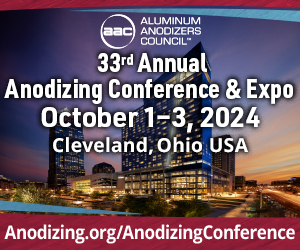Protection from Laser Marking on Aerospace Parts
We have a number of aluminum alloy aerospace products that are finished using either chemical film (MIL-C-5541) or anodizing in accordance with MIL-A-8625. Do we need to touch up the areas where laser markings have been placed in order to preserve the corrosion protection?
Q. We have a number of aluminum alloy aerospace products that are finished using either chemical film (MIL-C-5541) or anodizing in accordance with MIL-A-8625. The question has arisen of whether or not we need to touch up the areas where laser markings have been placed in order to preserve the corrosion protection. Is this a valid concern or not? —B.J.
A. I think your question regarding protection of the bare substrate on aerospace parts is an important one. There is a very straightforward answer, but providing you with some additional information may be in order. The answer to your question is one that must be determined as part of the contract or purchase agreement between the finisher and the customer. This is needed even if the "customer" is an internal one within the same company. So the customer and the finisher must reach agreement as to whether or not it is acceptable to have the bare substrate exposed, if the laser markings have penetrated the coating. If this is not acceptable, then there must be agreement as to how this situation will be handled by the finisher.
One scenario might be that the laser engraving could be done prior to the finishing operation. The situation to be addressed in that case is to make sure that the engraved area is, in fact, resistant to corrosion after the finishing operation has been completed. If required, salt spray testing could be done after anodizing or chem film. If anodized or chem-filmed parts are to be painted, the testing could be done after painting. It is the responsibility of the customer to determine this and pass this information along to the finisher.
Another scenario could be that the bare metal resulting from the engraving process done after finishing is simply touched up with a suitable conversion coating. Again, the parts may then be painted or not. You get the idea.
Not all laser engraving penetrates the anodic coating. This does not apply to parts that are chem film only. There are two types of lasers that are used for etching or scribing (laser engraving) metal surfaces. One is called YAG (yttrium, aluminum, garnet), a crystalline, solid-state laser that emits a beam at wavelength 1.064 micrometers (1064 nanometers). This type of laser is capable of scribing right through the anodic coating to expose the bare substrate. Turning the power to maximum will determine how deep the engraving is and how rough it leaves the metallic surface. I personally know of anodic coatings as thick as 2.0 mils (50 micrometers or microns) that are successfully engraved in this manner. Of course, the anodic coating is actually removed in this process. By operating on a very low power setting, the YAG laser is capable of removing "color" from an anodic coating without removing the coating itself. This only has viability for darker colored coatings.
The other type of laser engraver uses a combination of gasses (carbon dioxide, nitrogen and helium) to emit a wavelength of light (10.6 micrometers) that is the same as that of aluminum. Thus, the aluminum is reflective of this wavelength laser beam. The engraving mechanism then is to absorb dark colors present in the anodic coating. No anodic coating is actually removed. The rate of absorption of the color from the anodic coating is determined by the anodic coating thickness—more quickly absorbed in thinner coatings, less quickly in thicker coatings. So, if you had a black anodized coating or a Type I anodic coating, for instance, the laser absorbs the color, leaving the "white engraved" anodic surface. If the coating is clear anodized (Type II or IIB, for instance), the engraved results may be a mixed bag. With clear anodic coatings, the depth of "color" (usually shades of gray) is dependent on both the alloy and the temper of the part being engraved, as well as on the anodic coating thickness. Normally, the more coating thickness, the darker the "clear" color.
Related Content
Anodizing for Bonding Applications in Aerospace
Anodizing for pre-prep bonding bridges the gap between metallic and composite worlds, as it provides a superior surface in many applications on aluminum components for bonding to these composites.
Read MoreTop Shop’s Journey to Building a Unique Brand
Since this new Ohio plater took over the space and assets of a former plating business, it is intentional about setting itself apart from prior ownership.
Read MoreWhen the Stakes are High, Clean
Precision cleaning is critical for finishing aerospace oxygen system parts.
Read MoreHexavalent-Chromium-Free Aluminum Sacrificial Paint Validation
Hexavalent chromium is a known carcinogen, repro-toxin and mutagen. Its elimination is of high importance to the aerospace industry, which has struggled to find high performing alternatives. Legacy aluminum sacrificial paints have traditionally utilized hexavalent chromium to prevent corrosion and coatings which are equal to or better than have been difficult. This second of two papers discusses the hexavalent-chromium-free process from the user point-of-view in terms of the process validation work by Rolls Royce Corporation.
Read MoreRead Next
Powder Coating 4.0: Smarter, Faster, More Efficient and Connected
New tools reduce cost and waste, lower manufacturing footprint of powder coating operations.
Read MoreEpisode 42: An Interview with Robin Deal, Hubbard-Hall
Hubbard-Hall wastewater treatment specialist Robin Deal discusses the latest trends in wastewater management.
Read MoreThe 2024 Ford Mustang: All the Colors Available
Although Chevrolet has announced the end of the Camaro and Dodge is offering “Last Call” editions of the Charger and Challenger, the Ford Mustang is launching to its seventh generation.
Read More


























_KOCH.jpg;maxWidth=970;quality=90)